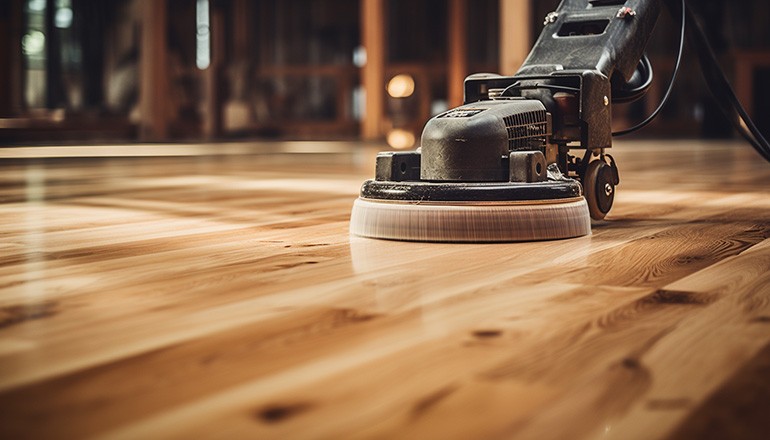
Whether you’re a homeowner in London or anywhere else across the United Kingdom, chances are you’ve encountered the need to renovate or maintain your home.
The maintenance tasks can be quite extensive, ranging from plumbing and roofing to landscaping and interior design. However, one area that often gets overlooked yet holds immense value is your wooden floors.
Wooden floors have been a staple in UK homes for centuries
According to the British Wood Flooring Association, roughly 60% of houses built before 1919 have original timber floors. When properly maintained, these floors can significantly enhance the aesthetic appeal and value of a home. This is where floor sanding and refinishing come into the picture.
The Costs Involved in Floor Sanding

The cost of floor sanding is one of the primary considerations for homeowners. It’s an investment that varies greatly depending on several crucial factors.
These factors can include the type of wood used in the flooring, the current condition of the wood, the total square footage of the floor area to be sanded, and the level of repair and restoration needed prior to the sanding process.
Each type of wood presents its own unique challenges and requirements when it comes to floor sanding.
For instance, hardwoods like oak or maple are more resistant to damage but may take more effort to sand effectively.
On the other hand, softer woods such as pine might be easier to sand but may require more care to avoid unnecessary damage. Therefore, the species of your wooden floor significantly influences the cost.
The existing condition of the wood also contributes to the overall costs.
Floors with extensive damage, stubborn stains, or old age may require more in-depth restoration work before the sanding process can even begin. This could include repairing damaged sections, removing stubborn stains, or replacing certain parts of the flooring.
Square footage is, of course, another crucial determinant of cost.
Larger floor areas will naturally require more time and resources to sand and refinish, thus increasing the overall cost of the project.
Another cost that homeowners should be aware of is the finish applied after the sanding process.
Finishes help to protect the floor and can enhance its appearance. Options for finishes include floor varnishing, staining, or sealing, each carrying its own price tag.
The average cost of floor sanding in the UK hovers around £200 to £500 per room. This estimation does not include additional charges for finishing processes like varnishing, staining, or sealing.
Specific to the London region, due to higher labour costs and often more extensive restoration requirements, the prices can be somewhat steeper.
According to a survey conducted by Resand.co.uk, a London-based floor sanding and wood floor polishing company, floor sanding services in the region can cost anywhere from £250 to £600 per room.
London homes, especially period homes with historical architectural designs, often have complex floor plans and intricate detailing. This can lead to increased costs due to the extra time and specialist skills needed to restore and sand these floors without compromising their original features.
Additionally, London’s competitive labour market contributes to the higher costs associated with floor sanding services in the city.
Therefore, while the cost of floor sanding may initially seem steep, it’s essential to consider the multiple factors influencing the price.
The Return on Investment (ROI)
The important question then is:
Is it worth it?
To answer this, we need to understand the return on investment (ROI) that floor sanding can offer.
A report by The National Association of Realtors (NAR) and the National Wood Flooring Association (NWFA) revealed that homeowners who install wood floors can expect a 70% to 80% return on investment, with some even reporting up to a 100% ROI.
When it comes to floor sanding and refinishing, the ROI may vary based on the state of the original flooring and the quality of the work done.
Our own data suggests that a well-executed floor sanding and refinishing project can boost the property’s value by up to 3-4%. For an average UK home valued at £230,000 as of 2022 (UK’s House Price Index), that equates to an increase of £5,750.
Furthermore, 90% of real estate agents agreed that houses with wood floors sell faster and for higher prices. So, not only does floor sanding improve the aesthetic of your home, it can also help to sell your house faster and at a higher price.
An Investment in Your Home’s Future
The cost of floor sanding, though often considered a mere expense, should rather be perceived as an investment in your home’s future.
This shift in perspective allows homeowners to value this process as a long-term advantage. To truly appreciate the significance of this investment, one must delve into the intrinsic value of wooden floors and the roles they play in our homes.
Restoring and maintaining the lustre of your wooden floors is akin to preserving an integral part of your home’s heritage.
Wooden floors bear the historical touch and charm that newer materials often lack.
They lend a sense of timeless elegance that transcends fleeting design trends, ensuring your home continues to impress, regardless of changing fashions.
In addition, they offer an architectural charm that can greatly enhance the market appeal of your property, setting it apart from others in an often competitive real estate market.
Wooden floors are more than just surfaces to walk on; they carry the aesthetic rhythm of your home. They are an essential element in your home’s design narrative, setting the tone and complementing other architectural features.
The rich tones and grain patterns found in wood bring an organic, warm, and comforting ambience, which can contribute to the overall wellbeing of the inhabitants.
This is where floor sanding comes into play.

Over time, wooden floors can lose their original lustre due to regular wear and tear, scratches, stains or the ageing of the sealant.
Floor sanding breathes new life into them, restoring their original beauty, and in many cases, revealing an even more captivating aesthetic underneath. This process strips away years of use, erases surface imperfections, and unveils the fresh, untouched wood beneath.
Wooden floors are a testament to durability and longevity.
When cared for properly, they can outlive most other flooring types, often lasting for several generations. Floor sanding is a crucial part of this maintenance regimen.
It not only enhances the look of your floors but also strengthens their structural integrity by removing any weak or damaged layers.
The upfront cost of floor sanding may deter some homeowners. However, the return on this investment – in terms of added home value, aesthetic appeal, durability, and the sheer joy of living with beautifully maintained wooden floors – should outweigh any initial reservations.
After all, investing in your home is essentially investing in your comfort, happiness, and future financial security.
The Final Verdict
Considering the costs and potential ROI, the case for floor sanding is clear.
Although it may require a significant upfront investment, the benefits in terms of added property value and enhanced aesthetic appeal far outweigh the costs.
Whether you’re preparing your home for sale or simply want to preserve its architectural integrity, investing in professional floor sanding and refinishing services will pay dividends in the long run.
Remember, the value is in the detail – and nothing brings out the detail in a wooden floor quite like professional sanding and polishing.
For homeowners in London and across the UK, enhancing your property’s value through floor sanding is just a call or click away.
Call Resand.co.uk today to request a quote and learn more about the services that can help protect and enhance the value of your home!

Lily Edwards is a dedicated blog author for ReSand.co.uk, using her background in Interior Design to write insightful articles on floor care, including sanding, oiling, and polishing.
When she's not crafting informative blog posts, Lily enjoys exploring the British countryside, antique hunting, and indulging her love for DIY home improvement projects.
